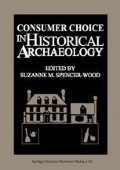Abstract
The trash deposits encountered within an historic site may be viewed as the end products of a series of purchase-use-discard incidents that took place during the occupation of that site. Under this approach, each step in this process represents distinct and measurable choices made by the individuals who generated the archaeological record under study. Each category of materials that entered the household (either by purchase or other means), that was used within the household, and that was subsequently lost or discarded (when no longer deemed useful), has the potential to reflect specific types of information about that household.
Access this chapter
Tax calculation will be finalised at checkout
Purchases are for personal use only
Preview
Unable to display preview. Download preview PDF.
References
Clark, D. T., 1984, Faunal Data, in: Final Archaeological Investigations at the Wilmington Boulevard Monroe to King Street Wilmington, New Castle County, Delaware, (DELDOT Archaeology Series, Number 29, T. H. Klein and P. H. Garrow, eds.), Dover, New York, pp. 545–683.
Crader, D. C., 1984, The Zooarchaeology of the Storehouse and the Dry Well at Monticello, in: American Antiquity 49:542–558.
Garrow, P. H. (ed.), 1982, Archaeological Investigations on the Washington, D.C., Civic Center Site, report on file with the Historic Preservation Office, Department of Housing and Community Development, Government of the District of Columbia.
Garrow, P. H., 1984, The Identification and Use of Context Types in Urban Archaeology, Southeastern Archaeology 3:91–96.
Heite, L. B., 1984, History, in: Final Archaeological Investigations at The Wilmington Boulevard Monroe to King Street Wilmington, New Castle County, Delaware, (DELDOT Archaeology Series, Number 29, T. H. Klein and P. H. Garrow, eds.), Dover, New York, pp. 29–82.
Heite, L. B., and Friedlander, A., 1984, Project Area Block Histories, in: Final Archaeological Investigations at The Wilmington Boulevard Monroe to King Street Wilmington, New Castle County, Delaware, (DELDOT Archaeology Series, Number 29, T. H. Klein and P. H. Garrow, eds.), Dover, New York, pp. 410–446.
Holt, C. A., 1984, Dietary Pattern Analysis, in: Final Archaeological Investigations at the Wilmington Boulevard Monroe to King Street Wilmington, New Castle County, Delaware, (DELDOT Archaeology Series, Number 29, T. H. Klein and P. H. Garrow, eds.), Dover, New York, pp. 368–386.
Klein, T. H., and Garrow, P. H. (eds.), 1984, Final Archaeological Investigations at the Wilmington Boulevard Monroe Street to King Street Wilmington, New Castle County, Delaware, (DELDOT Archaeology Series, Number 29, Dover, New York.
Miller, G. L., 1980, Classification and Economic Scaling of Nineteenth Century Ceramics, Historical Archaeology 14:1–40.
Miller, G. L., and Hurry, S. D., 1983, Ceramic Supply in an Economically Isolated Frontier Community: Portage County of the Ohio Western Reserve, Historical Archaeology 17:80–92.
Otto, J. S., 1975, Status Differences and the Archaeological Record—A Comparison of Planter, Overseer, and Slave Sites From Cannon’s Point Plantation (1794–1861), St. Simon’s Island, Georgia, University Microfilms, Ann Arbor.
Schulz, P. D., and Gust, S. M., 1983, Faunal Remains and Social Status in 19th Century Sacramento, Historical Archaeology 17:44–53.
Wheaton, T. R., Friedlander, A., and Garrow, P. H., 1983, Yaughan and Curriboo Plantations: Studies in Afro-American Archaeology, report on file with the National Park Service, Atlanta.
Author information
Authors and Affiliations
Editor information
Editors and Affiliations
Rights and permissions
Copyright information
© 1987 Springer Science+Business Media New York
About this chapter
Cite this chapter
Garrow, P.H. (1987). The Use of Converging Lines of Evidence for Determining Socioeconomic Status. In: Spencer-Wood, S.M. (eds) Consumer Choice in Historical Archaeology. Springer, Boston, MA. https://doi.org/10.1007/978-1-4757-9817-3_10
Download citation
DOI: https://doi.org/10.1007/978-1-4757-9817-3_10
Publisher Name: Springer, Boston, MA
Print ISBN: 978-1-4757-9819-7
Online ISBN: 978-1-4757-9817-3
eBook Packages: Springer Book Archive

